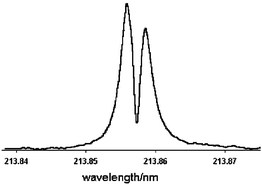Excitation of zinc in a Grimm-type glow discharge: effects of hydrogen and other excitation-related matrix effects†
Abstract
The excitation of zinc in the Grimm-type argon glow discharge was studied using a CCD and a FTS spectrometer. The effect of hydrogen, either originating from the sample or added at a low concentration to the discharge gas, on intensities of many zinc lines was investigated. Hydrogen was found to increase emission yields of all observed zinc lines, whilst the Zn I lines associated with the lowest triplet–triplet transitions are enhanced more than all Zn II lines and the Zn I line at 307.590 nm. The Zn I resonance line at 213.857 nm is enhanced more than those triplet–triplet Zn I lines. In the second part of this paper, excitation of zinc in pure argon discharge was studied, analysing Zn–Cu and Zn–Al alloys. The Zn I line at 307.590 nm is suppressed by copper and all Zn II lines are enhanced by aluminium. These effects can be corrected for by certain multiplicative corrections described in this paper, altering the emission yield of the affected zinc line. These data can be used in further work towards explanation of these effects, as well as for analytical interpretation of measurements in various GD-OES applications involving zinc.


 Please wait while we load your content...
Please wait while we load your content...